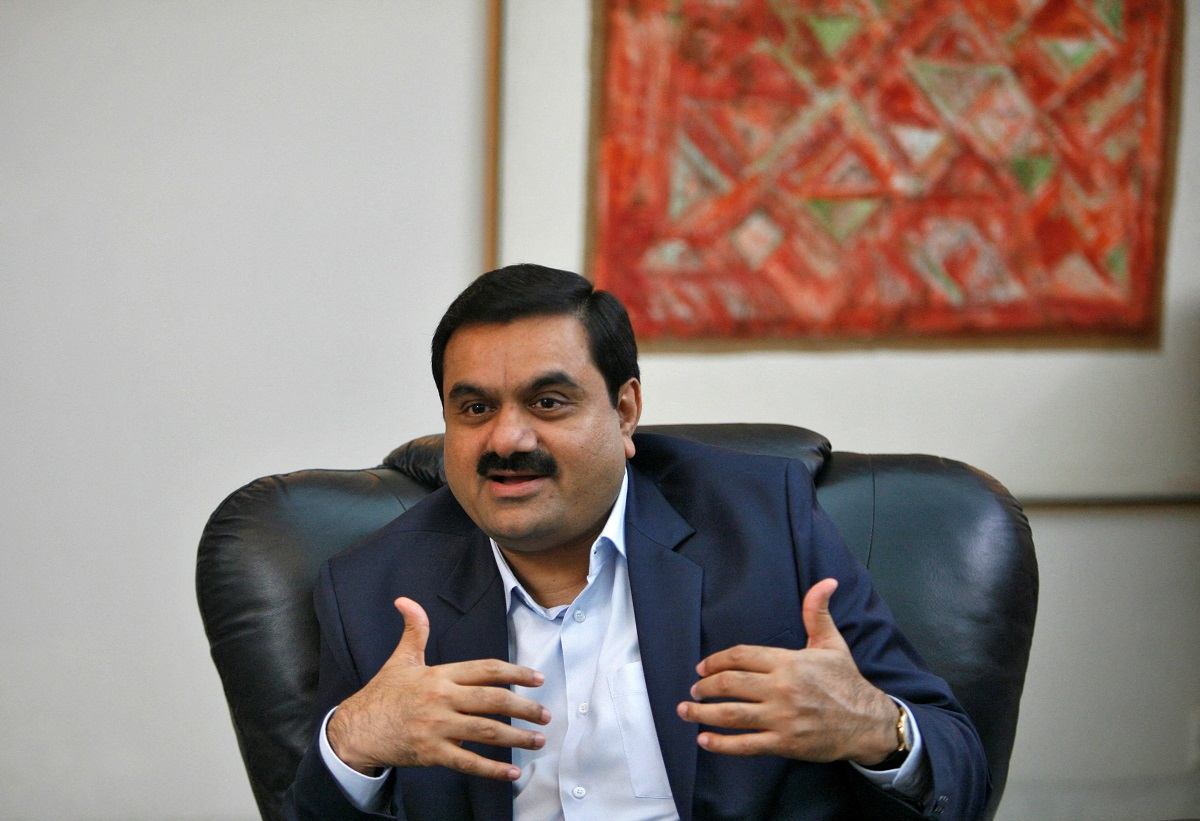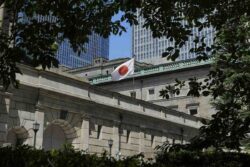
Indian billionaire Gautam Adani speaks during an interview in the western Indian city of Ahmedabad September 24, 2012. Picture taken September 24, 2012.
11:42 JST, January 29, 2023
Indian billionaire Gautam Adani, who last year briefly catapulted into becoming the world’s second richest person, has had a tough week. On Tuesday, he was accused of fraud and market manipulation by U.S.-based short sellers at Hindenburg Research, leading to the companies that he controls shedding tens of billions in value.
The fortune of Adani, who until recently had a net worth larger than that of Bill Gates and Warren Buffett, declined by more than $22 billion on Friday, according to Forbes, which tracks billionaire fortunes in real time. The seven publicly traded Adani companies, which are involved in everything including energy and infrastructure, lost more than $50 billion in market value this week, Bloomberg News reported.
Hindenburg, which is best known for a 2020 report about misrepresentations at electric vehicle company Nikola, said in research published after a two-year probe that Adani had pulled the “largest con in corporate history.”
Adani Group, the billionaire’s umbrella holding company, called Hindenburg’s charges “baseless and discredited,” and suggested the report was malicious in intent and timed to sabotage a secondary share sale of one of its companies.
Here’s what to know about the allegations surrounding the Indian energy baron who is Asia’s richest person.
– – –
Who is Gautam Adani?
Adani, 60, had a humble beginning. Born to a textile merchant in the western state of Gujarat, Adani spent his early career as a small-time plastics trader who traveled by scooter.
His big break came after India began liberalizing its economy in the early 1990s, and he was tasked with developing a deep-water port at Mundra, which now hosts the largest commercial port in the country. From there, his company expanded swiftly into infrastructure, logistics and energy, with coal-related businesses fueling his rise.
James Crabtree, an India specialist who wrote a book on the country’s billionaires, called Adani “modest” in a 2018 Australian Financial Review article.
“Both at home and abroad he also showed a debonair approach to debt . . . in a process that positioned him as perhaps the most financially aggressive of India’s newest generation of billionaires,” wrote Crabtree, who also noted that the tycoon worked out of an unpretentious office in his home state. (Adani is also a close ally of Indian Prime Minister Narendra Modi, who previously led Gujarat.)
Adani’s net worth has grown rapidly, from $9 billion in 2020 to $127 billion in December, during a broader boom in Indian capital markets. Forbes on Friday said he was worth just under $97 billion.
– – –
How big is the Adani empire?
Very, very big. Adani’s companies operate major Indian seaports, produce cement and sell cooking oil. He also recently acquired New Delhi Television, a leading English-language news channel that was one of the last networks seen as journalistically independent.
But coal remains at the heart of his empire, and he is the largest private developer of coal power plants and mines in the world, according to Global Energy Monitor. More than 60 percent of his holding company’s revenue was derived from coal-related business, The Washington Post reported in December.
His empire now stretches to sectors such as defense, renewable energy, transmission and infrastructure.
– – –
What are Adani’s connections to Narendra Modi?
Adani’s dizzying rise closely parallels the political career of Modi. The two men first met in the 1990s in their home state of Gujarat, when Adani was an up-and-coming businessman and Modi a promising, mid-level official in the Bharatiya Janata Party.
In the decades since, Adani has juggled ties with political leaders from across India, but the two seemed to mesh, associates of both men previously told The Post. The politician oversaw an infrastructure boom when he led Gujarat and came to respect Adani as an able operator, a former Modi adviser said.
After Modi was first elected prime minister in 2014, he flew to New Delhi from Gujarat in a private jet. A smiling Modi waved from the steps, with Adani’s purple logo looming behind on the plane. (Adani said in a 2016 interview with the Economic Times newspaper that the plane was not used by Modi for “free.”)
The Post reported in December that the Indian government on at least three occasions revised laws to help his coal businesses, saving him at least $1 billion. Critics such as Adani Watch, an Australian-based nonprofit, said the Hindenburg allegations, if proved true, “are just another example of what happens when crony capitalism and regime favoritism create a perceived culture of impunity.”
An Adani spokesperson declined to address the billionaire’s political relationships when provided with a list of questions ahead of The Post’s December report. An Adani associate, who spoke on the condition of anonymity because he was not authorized to publicly comment, told The Post that the billionaire’s success was due to his ability to support Delhi’s economic priorities, such as developing ports to transport coal when India faced shortages and building coal plants when the country needed electricity.
– – –
What are the fraud allegations leveled by Hindenburg?
Hindenburg published a report that accused the Adani Group of, among other things, artificially boosting the share prices of its firms over several decades by using a network of overseas shell companies linked to Adani’s family members. Hindenburg argued that Adani’s companies were collectively overvalued on India’s stock market by more than 80 percent.
The billionaire investor Bill Ackman in a tweet Thursday called Hindenburg’s report “highly credible” and “extremely well-researched.”
Indian markets halted trading of some Adani subsidiaries on Friday after a major sell-off.
– – –
What happens next?
Adani said it would look to initiate legal action against Hindenburg, which said it would welcome the challenge.
The sell-off has put the fate of an Adani company’s $2.45 billion secondary share sale, which opened Friday, in doubt. One market analyst said he was watching to see if the firm would withdraw its offering or lower its asking price.
The sharp drop in share prices means the “markets have taken the content of the report seriously,” said Hemindra Hazari, an independent research analyst.
The allegations bring into doubt the integrity of Indian capital markets, said Andy Mukherjee, an Indian economics commentator who writes for Bloomberg Opinion.
“This puts the Indian regulator in a difficult position about what it should do next: Seek to restore investor trust by thoroughly probing the allegations of market manipulation, or dismiss them as the handiwork of foreigners jealous with India’s rise?” he said in an email.
The case has also raised questions about the amounts that India’s public-sector bank have lent to Adani. Public-sector banks hold about 30 percent of the Adani Group’s debt, according to Hong Kong brokerage CLSA. The firm said the exposure was manageable even as debt held by the group’s five largest companies doubled in the past four years to $25.7 billion as of March.
"News Services" POPULAR ARTICLE
-

American Playwright Jeremy O. Harris Arrested in Japan on Alleged Drug Smuggling
-

Japan’s Nikkei Stock Average as JGB Yields, Yen Rise on Rate-Hike Bets
-

Japan’s Nikkei Stock Average Licks Wounds after Selloff Sparked by BOJ Hike Bets (UPDATE 1)
-

Japanese Bond Yields Zoom, Stocks Slide as Rate Hike Looms
-

Japan’s Nikkei Stock Average Buoyed by Stable Yen; SoftBank’s Slide Caps Gains (UPDATE 1)
JN ACCESS RANKING
-

Keidanren Chairman Yoshinobu Tsutsui Visits Kashiwazaki-Kariwa Nuclear Power Plant; Inspects New Emergency Safety System
-

Imports of Rare Earths from China Facing Delays, May Be Caused by Deterioration of Japan-China Relations
-

University of Tokyo Professor Discusses Japanese Economic Security in Interview Ahead of Forum
-

Japan Pulls out of Vietnam Nuclear Project, Complicating Hanoi’s Power Plans
-

Govt Aims to Expand NISA Program Lineup, Abolish Age Restriction

























